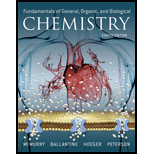
Concept explainers
(a)
Interpretation:
Cis-trans isomers for each compound are to be drawn.
Concept Introduction:
Stereoisomers: A compound has same molecular formula but differ in the spatial arrangement of atoms or groups in 3D-space.
Cis-isomer: In cis-configuration, the two identical substituents of the double bond are on the same side.
Trans-isomer: In trans-configuration, the two identical substituents of the double bond are on the opposite side and the term is included before the name as prefix.
(b)
Interpretation:
Cis-trans isomers for each compound are to be drawn.
Concept Introduction:
Stereoisomers: A compound has same molecular formula but differ in the spatial arrangement of atoms or groups in 3D-space.
Cis-isomer: In cis-configuration, the two identical substituents of the double bond are on the same side.
Trans-isomer: In trans-configuration, the two identical substituents of the double bond are on the opposite side and the term is included before the name as prefix.
(c)
Interpretation:
Cis-trans isomers for each compound are to be drawn.
Concept Introduction:
Stereoisomers: A compound has same molecular formula but differ in the spatial arrangement of atoms or groups in 3D-space.
Cis-isomer: In cis-configuration, the two identical substituents of the double bond are on the same side.
Trans-isomer: In trans-configuration, the two identical substituents of the double bond are on the opposite side and the term is included before the name as prefix.
(d)
Interpretation:
Cis-trans isomers for each compound are to be drawn.
Concept Introduction:
Stereoisomers: A compound has same molecular formula but differ in the spatial arrangement of atoms or groups in 3D-space.
Cis-isomer: In cis-configuration, the two identical substituents of the double bond are on the same side.
Trans-isomer: In trans-configuration, the two identical substituents of the double bond are on the opposite side and the term is included before the name as prefix.
(e)
Interpretation:
Cis-trans isomers for each compound are to be drawn.
Concept Introduction:
Stereoisomers: A compound has same molecular formula but differ in the spatial arrangement of atoms or groups in 3D-space.
Cis-isomer: In cis-configuration, the two identical substituents of the double bond are on the same side.
Trans-isomer: In trans-configuration, the two identical substituents of the double bond are on the opposite side and the term is included before the name as prefix.
(f)
Interpretation:
Cis-trans isomers for each compound are to be drawn.
Concept Introduction:
Stereoisomers: A compound has same molecular formula but differ in the spatial arrangement of atoms or groups in 3D-space.
Cis-isomer: In cis-configuration, the two identical substituents of the double bond are on the same side.
Trans-isomer: In trans-configuration, the two identical substituents of the double bond are on the opposite side and the term is included before the name as prefix.
Want to see the full answer?
Check out a sample textbook solution
Chapter 13 Solutions
Pearson eText Fundamentals of General, Organic, and Biological Chemistry -- Instant Access (Pearson+)
- D- and L- designations are used to distinguish between the two possible enantiomers of the monosaccharide, galactose. From the Fischer projection, determine the designation of this monosaccharide.arrow_forwardWhat's atropisomer?arrow_forwardIf Taxol (see Problem ) has a specific rotation of -49°, then what is the specific rotation of its enantiomer?arrow_forward
- The explosive trinitrotoluene (TNT) is made by carrying out three successive nitration reactions on toluene. If these nitrations only occur in the ortho and para positions relative to the methyl group, what is the structure of TNT?arrow_forwardFollowing are Fischer projections for a group of five-carbon sugars, all of which are aldopentoses. Identify the pairs that are enantiomers and the pairs that are epimers. (The sugars shown here are not all of the possible five-carbon sugars.) 1 СНО 2 СНО СНО Н-С—ОН Н-С—ОН Н—С—ОН Н-С—ОН НО —С—Н Н-С—ОН Н- С—ОН НО—С— Н НО—С—Н CH̟OH CH̟OH ČH̟OH в iоchemistry |61 STATE ATION Republic of the Philippines Romblon State University Romblan, Philippines 4 СНО 5 СНО 6 СНО НО—С—Н Н-С—ОН НО -С—Н Н—С—ОН НО -С—Н НО -С—Н H-C–OH Н-С—ОН НО—С—Н CH,OH ČH,OH CH,OHarrow_forwardWhat are examples of polyiodides? Include their structure.arrow_forward
- Following are Fischer projections for a group of five-carbon sugars, all of which are aldopentoses. Identify the pairs that are enantiomers and the pairs that are epimers. (The sugars shown here are not all of the possible five-carbon )arrow_forwardShown below is the structure of guanine. -NH N NH₂ -N H Draw the potential tautomers of guanine. Explain the potential risk of guanine (enol form) during S phase. (i) (ii) N ΙΖarrow_forwardDoes gentiobiose (Problem 20.66) have an acetal grouping? A hemiacetal grouping? Do you expect gentiobiose to be a reducing or nonreducing sugar? How would you classify the linkage (x or β and carbon numbers) between the two monosaccharides?arrow_forward
- Draw the structure of the tripeptide alanylglycylvaline and determine its name using three-letter abbreviations.arrow_forwardWhy is it not possible to find a five-fold symmetry operation in naturally-occurring crystals?arrow_forwardFollowing are Fischer projections for a groupof five-carbon sugars, all of which are aldopentoses. Identify thepairs that are enantiomers and the pairs that are epimers. (Thesugars shown here are not all of the possible five-carbon sugars.)arrow_forward
 Biology (MindTap Course List)BiologyISBN:9781337392938Author:Eldra Solomon, Charles Martin, Diana W. Martin, Linda R. BergPublisher:Cengage Learning
Biology (MindTap Course List)BiologyISBN:9781337392938Author:Eldra Solomon, Charles Martin, Diana W. Martin, Linda R. BergPublisher:Cengage Learning
